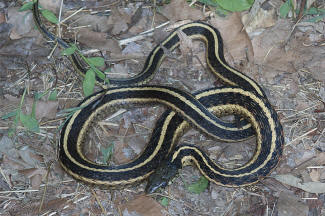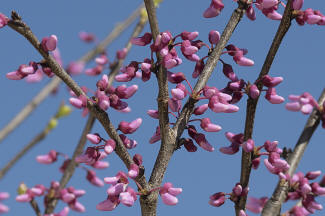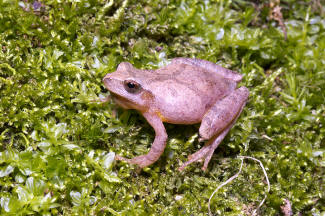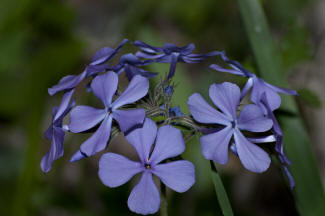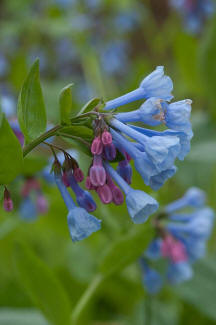PROFILES IN NATURE
Eastern Garter Snake
Photo Credit – www.kentuckyupclose.com
Yes, its that time of year. Although the recent cold spell has
ran most of the reptiles back underground it is not uncommon to see the
Eastern Garter Snake, Thamnophis sirtalis,
out from early spring on
through summer. Occasionally they may even be seen on some of the warmer
winter days.
Garter snakes are medium
sized with longitudinal stripes. Sometimes these stripes are broken so
as to form a checkered pattern. The background color ranges from
yellowish through brown, to bluish green. The belly is light colored
with dark spots. Average length is 16 to 26 inches.
The eastern garter snake is
viviparous and gives birth to live young. The number of young average
from 15 to 30. They are similar to adults but have stronger patterns.
These snakes seem to prefer to live near water or damp places but
can be found in almost any habitat. The garter snake feeds primarily on
earthworms, small toads and frogs, and salamanders.
By Jack
Glisson
Published in The Ballard County Weekly 04/01/2015
PROFILES IN NATURE
Eastern Redbud Tree
Photo Credit – www.kentuckyupclose.com
It seems that spring has finally arrived. We have had a few cool
spells and there will be more before summer brings lasting heat. But for
now everywhere one looks something is blooming. While most of our native
trees bloom white (sarvis and pear trees are in bloom now with dogwood
soon to follow), an
exception is the Eastern
Redbud Tree or Cercis canadensis.
With its pinkish/purple blossoms on bare twigs this small tree is a
welcome sight following a cold winter.
Redbuds are native to eastern North America and so tend to grow
well in our soil. Scattered in the wild or available from nursery stock
it is a common ornamental in our area. Although a fairly small tree
reaching a total height of only twenty to thirty feet it will spread
twisted branches to fill a canopy almost as wide as it is tall.
The pink blossoms are soon replaced by flat shaped seed pods and
heart shaped leaves. The leaves turn a bright yellow in fall putting on
a second seasonal show of color.
Twigs have been used for flavor in game meat and flowers can be
eaten raw or boiled. Although I have never tried them the mature seeds
were reportedly roasted and eaten by Indians.
As usual when describing edible or medicinal properties I must
add the following disclaimer,
neither the paper nor myself are responsible for the mis-identification
and/or possible untoward effects from eating or otherwise utilizing wild
plants.
By
Jack Glisson
Published in The Ballard County Weekly 04/08/2015
PROFILES IN NATURE
Northern Spring Peeper
Photo Credit – www.kentuckyupclose.com
Without a doubt spring has finally arrived. Although we will
still have a few cold spells the recent warm muggy weather has reptiles
and amphibians out in large numbers.
The Spring Peeper, scientific name
Pseucacris crucifer, is one
of two common frogs one hears in early spring, the other being the
chorus frog. Spring peeper males
sing mostly at night starting in early spring through early summer. The
best description I can think of to describe this little frogs call is
that it sounds like sleigh bells. They are very common throughout our
area.
During breeding season spring peepers congregate in low laying,
moist areas near water. The males usually climb a short distance up some
brushy structure and call to attract a mate.
These calls can be heard from up
to a couple of miles away if several frogs are calling. Eggs are laid in
shallow water and there may be up to one thousand of them!
Following breeding season these frogs retire into the forest.
They lead a secretive life and are rarely seen until the next spring
weather again brings them to breeding areas. Being nocturnal (active at
night) makes it even more unlikely to run across one unless turning over
logs or debris or other such cover.
Feeding on almost anything that moves and small enough to swallow
their diet includes flies, beetles, ants, and spiders.
By Jack
Glisson
Published in The Ballard County Weekly 04/15/2015
PROFILES IN NATURE
Downy Phlox
Photo Credit – www.kentuckyupclose.com
Out looking for turkey or just driving around, one is likely to
encounter this showy plant this time of year. Downy Phlox, also commonly
called wild phlox or prairie phlox is common in this area. The
scientific name for downy phlox is Phlox pilosa and there are actually
nine sub-species depending on the geographic location.
Downy phlox plants are from one to two feet tall and tend to grow
in clusters. Color can range from pink to blue. They are perennials
which means they come back year after year in the same location. The
foliage is present from early spring until fall but is rarely noticed
except for a brief flowering season in late spring to early summer.
Common on roadsides and river bottoms this plant seems to like areas
where the soil is warmed by sunshine early in the year before other
plants leaf out but later in the summer these same areas are then cooled
by shade.
This plants foliage is eaten most wild mammals and many long
tongue bees and butterflies feed from the nectar. However I find no
listing for nor have I ever heard of this plant being edible for humans.
It is however used extensively for gardens and landscaping. Available
from gardening supply houses or plant nurseries, propagation is by seed
or root rhizomes.
By Jack
Glisson
Published in The Ballard County Weekly 04/22/2015
PROFILES IN NATURE
Virginia Bluebell
Photo Credit – www.kentuckyupclose.com
Another spring wildflower common in our area this time of year is
the Virginia Bluebell, or Mertensia virginica.
The plant can grow over two feet tall and spreads by rhizomes
underground. This means that when found it may form dense patches that
may be a considerable size. Each flower is over an inch long so a patch
of these wildflowers is a showy sight. Fertile soil in partial shade
seems to be preferred. I have seen it mostly along creek banks.
The long tube of the flowers makes it difficult for some insects
to feed on the nectar but it is a favorite of butterflies which can
commonly be seen flitting from plant to plant.
I mentioned earlier that bluebell plants are spread by
underground rhizomes but it can also be propagated by seed. If seeds are
gathered they need to be sown immediately or frozen for around 6 weeks.
If rhizomes are dug it is best to do this when the plant is dormant.
Leaves and flowers of the Virginia bluebell are edible. Good
either raw in a salad or stir fried it can add a distinctive flavor to
other dishes.
As usual though, neither the
paper nor my-self are responsible for the mis-identification and
possible untoward side effects from eating unknown wild plants.
By Jack Glisson
Published in The Ballard County Weekly 04/29/2015
